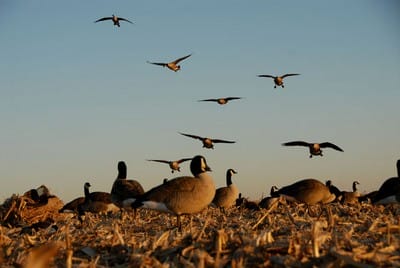
It’s a fact—nothing works all the time. And in no situation is this statement more valid than in goose hunting. Early season, mid-season, late season, it doesn’t matter. Often, the spread those big honkers absolutely fell into on Monday repels them on Thursday like garlic does Count Dracula. It’s the ultimate in trial and error, the goose gurus will tell you, and they’re right.
That being what it is, there are some goose spreads that most certainly fall under the heading of tried and true. These are the ones that produce in the majority—not always, but these rigs are the ones we goose junkies keep coming back to time and time again. Why? Because they work, that’s why.
Early Season: September through early October
The Junkyard Spread: Scott Threinen, a competitive goose caller from Minnesota and creator of the Bad Grammar instructional calling DVD, used the term junkyard spread in an interview recently. Early season geese, said Threinen, are often uneducated geese. These naïve birds can often be duped with a combination spread of silhouettes, shells, full-bodies, or whatever a hunter has. The key, said Threinen, is to elevate your spread as the birds themselves progress, or grow wiser. Equally important is not showing your entire hand the first week of the season.
“Don’t give the birds their diplomas,” said Threinen. “Make them earn it.”
There’s no need to come out of the starting gate with 10 dozen fully flocked full-bodies—keep those in reserve until you really need them.
A Family Affair: Small family groups of widely-spaced Canada decoys—five here, four there, another four there—are an excellent idea during the early season. Realize, though, that family groups don’t necessarily carry on throughout the season. Once the weather turns and food sources go from plenty to a premium, it’s every bird for himself. Then, you are either dealing with the Big Black Blob Theory of goose decoy placement, especially true with the smaller subspecies like lessers or cacklers, or individual decoys placed more or less an equal distance apart.

Mid-season: Early October through late November or early December
Lunch Lines: Good friend, Travis Mueller, incorporates what he calls lunch lines into his goose spreads, especially during the late season when the birds’ stomachs dictate many of their actions and reactions.
“Lunch lines,” said Avery Territory Manager Mueller, “are just staggered lines of decoys that appear to ‘walk’ into the main body of the spread. These represent geese that have just landed, and are hot-footing it into an area of heavy feeding activity. Essentially these lines direct incoming birds where they want to be and where I want them.”
During bouts of nasty weather, Mueller said, geese will often “cut the lines,” trying to get ahead of birds arriving behind them. Gunners should concentrate, then, on these areas.
Silhouettes Revisited: “The problem with a full-body spread is absolutely no movement,” said Freddie Zink of Zink Calls. “By mixing silhouettes throughout your spread of full-bodies and shells, the appearing-n-disappearing act that the silhouettes do is the same thing that flashing wing decoys do or flagging does. It gives the illusion of movement in the spread.”

But Freddie said this with caution. “I’ll mix decoys when I’m hunting flight birds or migrators, or when I’m looking for sheer numbers of decoys in the field. On the everyday hunt, I don’t mix decoys. When geese come into a mixed spread—silhouettes, shells, and full-bodies—they quickly grow accustomed to all three types of decoys at the same time. Once they get smart to all three and you pull one or two, they’ve still seen the remaining style.”
The answer? “I’m constantly rotating the type of decoy I’m using,” said Zink.
Late season: Late November/early December to season’s End
Sleeper Shells: “I do most of my late season hunting in northern Nevada or Colorado, where frozen ground, heavy frost, or snow is common,” said Avery Outdoors pro-staffer, Chad Belding, “Almost exclusively, I use shells at this time because often, the first thing Canadas do when they hit these hard fields is lay down. There may be a couple standing guard, but almost all of the birds will be lying down. They’re letting their body heat melt the ground enough so they can get to the food underneath. Then they’ll simply eat where they’re at—just peck at the ground without getting up.”
Before commercial sleeper decoys were available, Belding used shells minus the heads in order to present that all-tucked-in look. Today, he doesn’t find it necessary to go headless.
“I like the Greenhead Gear oversized shells with the flocked heads,” he said. “They’re very realistic, and are the exact body posture of a Canada lying on the ground.”
Fully flocked decoys, he claims, are even better on snow or ice or under extremely cold conditions. “The flocking—those tiny poly-fibers—retain heat better and longer, and help the decoy resist frosting.”







